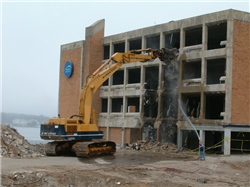By: Chris Hall
Bringing down a building or any other structure is an inherently dangerous work activity. Not only must the demolition contractor follow OSHA safety standards, but they must also conform to state and local regulations. Without an appropriate level of planning and protection it is likely that personal injuries, premature collapse, or damage to other structures will plague the process. The following are several considerations and requirements established by OSHA and ANSI (A10.6-1983 – Safety Requirements for Demolition Operations) to ensure operations take place in the safest manner possible.
The first step required is to have an engineering survey performed by a competent person to determine the stability and construction of the structure. The purpose of this is to prevent any premature collapse of part of the structure, or adjacent structure during the activities. Consideration should be given to public access to adjacent areas, fire potential, possible cave-ins, and other site specific hazards. If the building has been damaged by fire or natural disaster, it may be necessary to brace or shore walls and floors. The chemical or environmental hazards of the structure must also be determined; Asbestos, lead paint, stored or used chemicals may contaminate the jobsite. Employee safety, public safety, and environmental protection must be top priorities.
Once the engineering survey is completed, location of utility services is necessary to prevent accidental strikes. Electric, gas, water, steam, sewer, fiber optic, or other services must be identified and shut down from the exterior of the structure. The utility companies must be contacted and notified far enough in advance to give enough time to disconnect their respective services. It is important to obtain documentation of utility disconnects and verify, if possible, that services are no longer live. If any service is needed to complete the demolition, it must be moved temporarily.
In the event of an injury, arrangements must be made for prompt medical treatment and transportation. Numbers to the nearest hospital, emergency services, and physicians must be posted on the jobsite. If no medical services are available within a reasonable time frame (between 3-5 minutes), there must be at least one person onsite certified in first aid onsite at all times. This also includes the accessibility of a fully stocked first aid kit. The numbers for local police and fire departments must be posted (if 911 service is not available), in the event of a fire or other activity where services may be needed.
A fire prevention plan must be established prior to work. This includes information for key personnel, reporting procedures, and evacuation plan. It must include protection provisions for heating devices, smoking policies and locations, clear access paths for emergency equipment, free access to fire protection equipment such as fire extinguishers or hydrants, and an alarm or notification system (air horns, siren, two-way radios, etc.).
Other considerations would have to be made if the structure is a high rise, stack, cooling tower, pre-stressed concrete, monolithic, or of any other type of design. In most cases, a registered professional engineer, qualified in that form of construction, must be consulted for advice for an appropriate method of demolition. In many cases of catastrophic accidents in demolition work, these structures are not evaluated properly and injuries result from premature collapse or debris falling or flying beyond the demolition area.
If blasting is to be used as a form of demolition, a written survey must be performed to establish the effects of blasting on adjacent structures, underground utilities, and any areas surrounding the structure site. Blasting is a highly dangerous activity with many regulations enforced by OSHA, state, and local governments. A qualified blaster is required to be in charge of any activities involving explosives, including transportation, storage, handling, and use. A blaster must be able to provide evidence of qualifications and be included in all stages of planning the operation which involves the use of explosives.
Demolition activity is not as simple as just tearing down a structure. It must involve a high level of planning and engineering surveys. Whether it is a partial demolition or complete structure these pre-work assessments must be made in order to prevent unnecessary accidents and injuries.
Related Topics: Demolition Safety, Safety Articles, Monthly Safety Topics